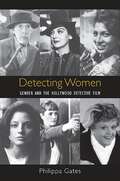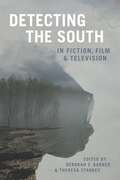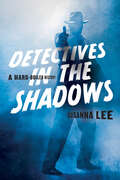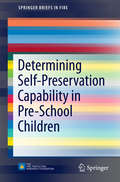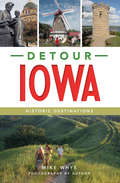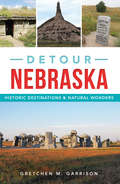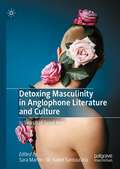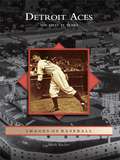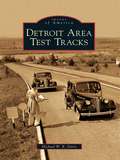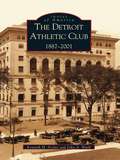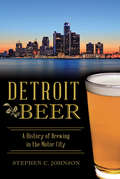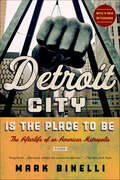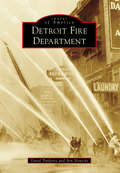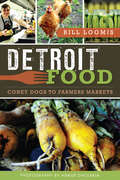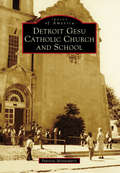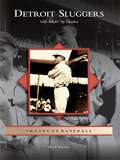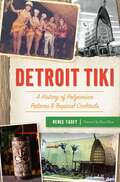- Table View
- List View
Detecting Women: Gender and the Hollywood Detective Film
by Philippa GatesFinalist for the 2012 Edgar Award in the Best Critical/Biographical Category presented by the Mystery Writers of AmericaIn this extensive and authoritative study of over 300 films, Philippa Gates explores the "woman detective" figure from her pre-cinematic origins in nineteenth century detective fiction through her many incarnations throughout the history of Hollywood cinema. Through the lens of theories of gender, genre, and stardom and engaging with the critical concepts of performativity, masquerade, and feminism, Detecting Women analyzes constructions of the female investigator in the detective genre and focuses on the evolution of her representation from 1929 to today. While a popular assumption is that images of women have become increasingly positive over this period, Gates argues that the most progressive and feminist models of the female detective exist in mainstream film's more peripheral products such as 1930's B-picture and 1970's Blaxploitation films. Offering revisions and new insights into peripheral forms of mainstream film, Gates explores this space that allows a fantasy of resolution of social anxieties about crime and, more interestingly, gender, in the 20th and early 21st centuries. The author's innovative, engaging, and capacious approach to this important figure within feminist film history breaks new ground in the field of gender and film studies.
Detecting the South in Fiction, Film, and Television (Southern Literary Studies)
by Ace Atkins Megan Abbott Greg Herren Phoebe Bronstein James A. Crank Suzanne Leonard Scott Romine Harriet Pollack Gina Caison Riche Richardson Zackary Vernon Jacob Agner R. Bruce Brasell Claire Cothren Dominiqua Dickey Leigh Anne Duck Bob Hodges Sarah Leventer Kristopher Mecholsky Yajaira M. Padilla Jacqueline Pinkowitz Randall WilhelmDetecting the South in Fiction, Film, & Television, edited by Deborah E. Barker and Theresa Starkey, examines the often-overlooked and undervalued impact of the U.S. South on the origins and development of the detective genre and film noir. This wide-ranging collection engages with ongoing discussions about genre, gender, social justice, critical race theory, popular culture, cinema, and mass media. Focusing on the South, these essays uncover three frequently interrelated themes: the acknowledgment of race as it relates to slavery, segregation, and discrimination; the role of land as a source of income, an ecologically threatened space, or a place of seclusion; and the continued presence of the southern gothic in recurring elements such as dilapidated plantation houses, swamps, family secrets, and the occult. Twenty-two critical essays probe how southern detective narratives intersect with popular genre forms such as neo-noir, hard-boiled fiction, the dark thriller, suburban noir, amateur sleuths, journalist detectives, and television police procedurals. Alongside essays by scholars, Detecting the South in Fiction, Film, and Television presents pieces by authors of detective and crime fiction, including Megan Abbott and Ace Atkins, who address the extent to which the South and its artistic traditions influenced their own works. By considering the diversity of authors and characters associated with the genre, this accessible collection provides an overdue examination of the historical, political, and aesthetic contexts out of which the southern detective narrative emerged and continues to evolve.
Detectives in the Shadows: A Hard-Boiled History
by Susanna LeeA century of American history reflected in the iconic private eye.Steadfast in fighting crime, but operating outside the police force—and sometimes even the law—is the private detective. Driven by his own moral code, he is a shadowy figure in a trench coat standing on a street corner, his face most likely obscured by a tilted fedora, a lit cigarette dangling from his hand. The hard-boiled detective is known by his dark past, private pain, and powers of deduction. He only asks questions—never answers them. In his stories he is both the main character and the narrator.America has had a love affair with the hard-boiled detective since the 1920s, when Prohibition called into question who really stood on the right and wrong side of the law. And nowhere did this hero shine more than in crime fiction. In Detectives in the Shadows, literary and cultural critic Susanna Lee tracks the evolution of this truly American character type—from Race Williams to Philip Marlowe and from Mike Hammer to Jessica Jones. Lee explores how this character type morphs to fit an increasingly troubled world, offering compelling interpretations of The Wire, True Detective, and Jessica Jones. Suddenly, in the present day, the hard-boiled detective wears his—or her—fatigue outwardly, revealing more vulnerability than ever before. But the detective remains resolute in the face of sinister forces, ever the person of honor. For anyone interested in crime fiction and television, or for those wanting to understand America's idolization of the good guy with a gun, Detectives in the Shadows is essential reading.
Determining Self-Preservation Capability in Pre-School Children
by Anca Taciuc Anne S. DederichsThis SpringerBrief explores the evacuation characteristics of children and their self-preservation capability during fire situations. An international survey among teachers from day-care centers and experts in child development indicates an age-limit at which pre-school children may be considered capable of evacuating a location without direct intervention by an instructor. The survey examines the ability of children to understand and follow simple instructions, walk on horizontal surfaces without physical support, and walk down stairs. It also studies how fire safety installations and fire drills differ between countries. A literature review and a presentation of the method applied are included. This data can be applied to evacuation procedures, building codes, and fire regulations. Determining Self-Preservation Capability in Pre-School Children is intended for practitioners as a tool for analyzing evacuation safety issues and developing methods removing potential hazards. Researchers working in a related field will also find the book valuable.
Detonography: The Explosive Art of Evelyn Rosenberg
by Evelyn RosenbergArtist Evelyn Rosenberg invented a remarkable technique to make sculpture by forming metal with plastic explosives. After many months of experiments in the mid-1980s with an Israeli explosives engineer, she discovered how to refine this unique process to make large-scale, intricately designed works of art and named the new art form Detonography. Working in the New Mexico desert, near where the first atomic bomb was tested at the Trinity Site, she transforms powerful weapons of destruction into tools of creation.In this book, the first to showcase her work, she describes the history and genesis of Detonography and explains from conception to installation how a piece of explosive art is made. Her method is documented step by step with the richly detailed photography of John Trotter, a personal history, and an essay by Gideon Sivan, the explosives expert whose technical work served as Rosenberg&’s original inspiration.
Detour Iowa: Historic Destinations
by Mike WhyeIowa history ranges from the natural to what's been made by humans over many centuries. Find and hold the fossilized remains of sea creatures that lived 375 million years ago. Walk through a small-town home where one of the nation's most infamous--and unsolved--murders occurred in 1912. Savor pastries that originated in the Netherlands before the 1840s and watch where wheat is ground into flour in a windmill first built in Denmark and then rebuilt in Elk Horn. Listen to time softly tick away in an elaborately carved clock that auto pioneer Henry Ford tried and failed to buy in 1928 for $1 million. Join writer-photographer Mike Whye on trips to the known, little-known and unknown historic places in Iowa.
Detour Nebraska: Historic Destinations & Natural Wonders
by Gretchen M. GarrisonFor many, Nebraska is the flat prairie seen from the interstate. Yet with the Sandhills, bluffs and river valleys, the state has an abundance of riches. The heritage of early settlers is evident. Fort Kearny and Chimney Rock were pioneer harbors. The Fur Trade Museum and the Homestead Monument of America tell of those who came to make a life. Carhenge is a nationally known treasure. The Joslyn Art Museum features world-class art, and the Nebraska National Forest is the largest hand-planted forest in the nation. Native Nebraskan Gretchen Garrison details the places and people that make the Cornhusker State unique.
Detour New Mexico: Historic Destinations & Natural Wonders
by Arthur Pike David PikeNew Mexico’s rich and varied history is easily accessible via detours down obscure backroads and overlooked off-ramps. By taking the road less traveled in any direction, visitors can experience ancient landmarks, cultural heritage sites and striking vistas. Stop at places along the old Route 66, sample the world’s best chiles by the Rio Grande or soak in geothermal water flowing under Truth or Consequences. Ancient dwellings in remote canyons, the town where the first atomic bomb was secretly assembled and the grave of Billy the Kid all lie off the beaten path in the Land of Enchantment. Authors Arthur and David Pike map out these and many more worthwhile points of interest for the curious traveler.
Detoxing Masculinity in Anglophone Literature and Culture: In Search of Good Men
by Sara Martín M. Isabel SantaulàriaThis edited volume rethinks Masculinity Studies by breaking away from the notion of the perpetual crisis of masculinity. It argues that not enough has been done to distinguish patriarchy from masculinity and proposes to detox masculinity by offering a collection of positive representations of men in fictional and non-fictional texts. The editors show how ideas of hegemonic and toxic masculinity have been too fixed on the exploration of dominance and subservience, and too little on the men (and the male characters in fiction) who behave following other ethical, personal and socially accepted patterns. Bringing together research from different periods and genres, this collection provides broad, multidisciplinary insights into alternative representations of masculinity.
Detroit Aces: The First 75 Years (Images of Baseball)
by Mark RuckerEver since the city was granted its first major league team, the Wolverines in 1881, Detroit baseball fans have packed the parks to loyally cheer for their favorite hurlers on the mound. In 1887, Charlie Getzein, nicknamed "Pretzels," led the Detroit ball club to its first National League pennant with 29 wins. The rubber-armed "Wild" Bill Donovan led the Detroit Tigers to the city's first American League pennant in 1907, notching up an astounding .862 winning percentage despite a legendary lack of control. More great pitchers were to follow in the coming decades, and, written from the perspective of an old-time fan, Detroit Aces: The First 75 Years is a fun read for any Motor City baseball enthusiast.
Detroit Area Test Tracks (Images of America)
by Michael W. DavisThe catastrophic failure of a new but unproven copper-cooled Chevrolet in 1923 led the General Motors Corporation to buy back the 100 cars it had sold to the public and recall another 400 in company and dealer hands. As a result, in 1924 General Motors started building the industry's first scientific proving ground to test new vehicle designs before they were released for production and sale. Before this, all automakers tested new cars haphazardly on public roads and within limited engineering laboratories. Better known by the public as test tracks, the proving grounds became a source of curiosity for decades about the secrets they might hold. Detroit Area Test Tracks goes behind the test track walls to show how the facilities evolved and what typically takes place inside.
Detroit Athletic Club, The: 1887-2001 (Images of America)
by John A. Bluth Kenneth H. VoylesSince its establishment 114 years ago, the Detroit Athletic Club (DAC) has played a crucial role in the amazing history of the City of Detroit. Originally a club for amateur athletes, it was reorganized in 1913 by prominent automobile and industrial leaders. In that year, Albert Kahn, a renowned architect, designed the magnificent six-story clubhouse that still stands in the heart of Detroit's theatre and sports district.Beginning with the birth of the original club on Woodward Avenue in 1887, this book chronicles the history of the DAC up to the present, in over 200 vintage photographs-many never before seen outside of the club. Images gathered from the club's archives cover the formative years at the first club, the building and opening of the new club, the DAC's great athletic traditions, its membership and staff, social activities, the art of the DAC and its magnificent restoration at the end of the 20th century.
Detroit Beer: A History of Brewing in the Motor City (American Palate)
by Stephen C. JohnsonWhile in recent years Detroit's craft beer scene has exploded with activity and innovation, brewing has a long history in the Motor City. Small brewers popped up during the mid-1800s to support nearby saloons. Many breweries survived the dry years by producing "near beer," or non-alcoholic beer, which was quickly abandoned after Prohibition. Consolidation marked the following decades until only Stroh Brewery Company remained. Local brewing returned triumphantly with dozens of breweries opening their doors since the 1990s, including Motor City Brewing Works, Atwater Brewery and Kuhnhenn Brewing Company. Join author and Motor City Brew Tours founder Stephen Johnson for Detroit history by the pint.
Detroit City Is the Place to Be: The Afterlife of an American Metropolis
by Mark BinelliOnce America's capitalist dream town, Detroit is our country's greatest urban failure, having fallen the longest and the farthest. But the city's worst crisis yet (and that's saying something) has managed to do the unthinkable: turn the end of days into a laboratory for the future. Urban planners, land speculators, neopastoral agriculturalists, and utopian environmentalists—all have been drawn to Detroit's baroquely decaying, nothing-left-to-lose frontier.With an eye for both the darkly absurd and the radically new, Detroit-area native Mark Binelli has chronicled this convergence. Throughout the city's "museum of neglect"—its swaths of abandoned buildings, its miles of urban prairie—he tracks both the blight and the signs of its repurposing, from the school for pregnant teenagers to a beleaguered UAW local; from metal scrappers and gun-toting vigilantes to artists reclaiming abandoned auto factories; from the organic farming on empty lots to GM's risky wager on the Volt electric car; from firefighters forced by budget cuts to sleep in tents to the mayor's realignment plan (the most ambitious on record) to move residents of half-empty neighborhoods into a viable, new urban center.Sharp and impassioned, Detroit City Is the Place to Be is alive with the sense of possibility that comes when a city hits rock bottom. Beyond the usual portrait of crime, poverty, and ruin, we glimpse a longshot future Detroit that is smaller, less segregated, greener, economically diverse, and better functioning—what could be the boldest reimagining of a post-industrial city in our new century. Detroit City Is the Place to Be is one of Publishers Weekly's Top 10 Best Books of 2012
Detroit Fire Department (Images of America)
by David Traiforos Arn NowickiOnce known as the "Paris of the West," Motown became synonymous with urban abandonment and arson as job and population decline took hold in the late 20th century. No other fire department has experienced the hardships of the job on such a consistent basis as the Detroit Fire Department (DFD). Detroit firefighters have ridden the waves of unprecedented prosperity and tragic decline. Determined faces mask many layoffs, station closings, and a reduction in workforce. Despite these perils, dedication and the belief in their city remains a constant among Detroit firefighters. The official Detroit motto, "We hope for better things; it shall rise from the ashes" holds as true today as it did when first uttered over 100 years ago.
Detroit Food: Coney Dogs to Farmers Markets (American Palate)
by Bill LoomisThe infamous images of Detroit's crumbling buildings, abandoned homes and weed-choked parks are known worldwide. Seldom shown are the city's thriving food ways, quietly rebuilding neighborhoods block by block with urban farms, locally made fare, new restaurants and an innovative, homegrown spirit that is attracting entrepreneurs and culinary enthusiasts from across the nation. Old neighborhoods are coming back to life with the smell of simmering soup, the crunch of new pickles and the aroma of all-day barbeque. Magnificent Art Deco clubs and speakeasies painstakingly restored to their former beauty are busy serving great local food. Author Bill Loomis goes behind the graffiti and ruins to explore how the passion for eating well is proving essential to Detroit's comeback..
Detroit Gesu Catholic Church and School (Images of America)
by Patricia MontemurriIn a reconfigured farmhouse just a mile outside of the city limits of Detroit, a Jesuit priest and 25 men, women, and children gathered to celebrate Sunday mass on March 19, 1922. The Reverend John McNichols named the Catholic mission church Gesu, the Italian word for �Jesus.� Gesu became one of Detroit�s landmark parishes. Its history illustrates the Motor City�s boom, bust, resilience, and resurgence. It was the home parish of four Detroit mayors, powerful members of Congress, auto industry titans, sports legends, artists, authors, and actors. At its peak in the mid-1960s, Gesu School enrolled 1,600 students. Because of Detroit�s decline and its racial and economic struggles, Gesu is one of only four Catholic elementary schools that remain in the city. But as Detroit rebounds, Gesu School is growing again.
Detroit Opera House (Images of America)
by Marianne Weldon Michael HauserThe theater known today as the Detroit Opera House has been an integral part of the city's culture and history as well as the live entertainment industry. Its existence has been threatened in the past, but it has survived wars, the Great Depression, civil unrest, economic meltdowns, the abandonment of downtown, and, most recently, a pandemic. Generations of patrons have fond, vivid memories of attending films, stage presentations, or events with family and friends as it transitioned from the Broadway Capitol to the Paramount to the Grand Circus to the Detroit Opera House. The reason for building these "temples of amusement" was to literally transport a guest into another world, and the Detroit Opera House has valiantly fulfilled that task. What began as an idea by David DiChiera, founder of Michigan Opera Theatre, the owner and operator of today's Detroit Opera House, blossomed into a magnificent performing arts center with its formal opening in 1996.
Detroit Sluggers: The First 75 Years (Images of Baseball)
by Mark RuckerEver since the city was granted its fi rst major-league team, the Wolverines in 1881, Detroit baseball fans have packed the parks to loyally cheer for their favorite sluggers at the plate. Big Dan Brouthers helped the Detroit ball club win its first National League pennant with 12 home runs, 101 RBIs, and a league-leading 153 runs scored in 1887. Twenty years later, a rookie named Ty Cobb, at the start of a hall-of-fame career, led the league in batting and the Tigers to three successive American League pennants. Hank Greenberg, Rudy York, and Al Kaline joined the ranks of Motor City sluggers in the coming decades who thrilled fans with the long ball in pennant race after exciting pennant race. Written from the perspective of an old-time fan, Detroit Sluggers: The First 75 Years is a fun read for any Motor City baseball enthusiast.
Detroit Tiki: A History of Polynesian Palaces & Tropical Cocktails
by Renee TadeyWhen the South Sea craze swept over the nation in the mid-twentieth century, the wave of island-themed décor and tropical cocktails did not pass by Detroit. The Tropics and Club Bali offered a warming escape from dreary Midwest winters. At its completion in 1967, the Mauna Loa was the most expensive restaurant built east of the Mississippi. With its lush interior and celebrity patrons, it did not disappoint. The Chin Tiki, with its exquisitely handcrafted features, was no less an exceptional destination. Even today, long after the Polynesian craze has faded, a new generation has taken up the tiki torch and brought island flavor and flair back to the city. Join author Renee Tadey on a sweeping journey through the tiki destinations of Detroit.
Detroit on Stage: The Players Club, 1910-2005 (Great Lakes Books Series)
by Marijean LeveringFounded in 1910, Detroit’s Players Club is an all-male club devoted to the production of theater by members for other members’ enjoyment. Called simply "The Players," members of the club design, direct, and act in the shows, including playing the female roles. In Detroit on Stage, Marijean Levering takes readers behind the scenes of the club’s private "frolics" to explore the unique history of The Players, discover what traditions they still hold dear, and examine why they have survived relatively unscathed through changes that have shuttered older and more venerable institutions. The Players developed during a nationwide vogue for community and art theater and also as Detroit’s auto elites were in the midst of forming new private clubs to add to their own sense of prestige. By the 1920s, The Players had built their own playhouse and established most of their significant traditions, including the monthly frolics, at which the members perform for each other. At the frolics, members in the audience would wear tuxedos and drink beer out of personalized mugs, customs that remain to this day. Prominent Detroiters have always been among the ranks of the Players, and several well-known auto industry figures were members from the beginning, including banker Henry B. Joy, Oldsmobile sales manager Roy D. Chapin, and Ford executives James Couzens and Edsel Ford. Over the decades that followed the club’s founding, its membership and traditions have remained strong despite major world events that shook Detroit such as Prohibition, the Great Depression, and World War II. In looking at The Players of today, Levering explores the camaraderie and sense of history that has kept the club together and relatively unchanged throughout the years. She also examines the club’s notable members and its unique place in Detroit history. Detroit on Stage places The Players club in the broader contexts of social clubs, explaining how these organizations originate and function. Readers interested in Detroit cultural history and theater studies will enjoy this rare glimpse inside a long-standing Detroit cultural institution.
Detroit's Corktown (Images of America)
by Armando Delicato Julie Demery Workman’s Rowhouse MuseumDetroit's Corktown celebrates the history of Detroit's oldest neighborhood. From Irish immigrants in the 1840s to urban pioneers of the 21st century, this community has beckoned to the restless of spirit, the adventurous, and those who have sought to escape poverty and oppression to make a new life in America. While the city of Detroit has undergone tremendous change over the years, Corktown has never forgotten the solid working-class roots established by brave pioneers in the mid-19th century. Many of their shotgun homes are still occupied, and many commercial buildings have served the community for decades. Today the neighborhood is the scene of increasing residential and commercial development and has attracted attention throughout the region. No longer exclusively Irish, the community has also been important historically to the large German, Maltese, and Mexican populations of Detroit. Today it is a diverse and proud community of African Americans, Hispanics, working-class people of various national origins, and a growing population of young urban pioneers. It is still the sentimental heart of the Irish American community of metropolitan Detroit, and the Irish Plaza on Sixth Street honors the city's Irish pioneers and their 600,000 descendents living in the region.
Detroit's Deaf Heritage (Images of America)
by Kathleen Brockway Detroit Association of the DeafDetroit, the Motor City, welcomed many newcomers to work and interact in the deaf community in the early 20th century. The booming job market attracted Benjamin and Ralph Beaver, deaf brothers from Iuka, Illinois, who helped form the Detroit Association of the Deaf (DAD) Club--celebrating its 100th anniversary in 2016. Others included the Wahowiak family, who ran a shoe repair business in Upper Michigan for two deaf generations; Arlyn Meyerson, a deaf restaurateur for 55 years; Glenn Stewart, the first black deaf man graduated from Rochester Institute of Technology; and Dudley Cutshaw, a longtime deaf local leader. In addition, Grand Rapids, Flint, and Upper Michigan each contributed to this great deaf heritage by affiliating with Detroit's deaf community. Through vintage photographs of successful organizations, including Catholic Deaf Organization, Motor City Association of the Deaf, Black Silent Club, Michigan Deaf School, and Flint Association for the Deaf, Detroit's Deaf Heritage illustrates the evolution of the deaf community and its prominent leaders.
Detroit's Historic Hotels and Restaurants (Postcard History Series)
by Patricia IbbotsonDetroit's population grew rapidly after the beginning of the 20th century due to the growth of the automobile and other industries, and the city became a tourist and convention center. Detroit was in its heyday in the 1920s when it was the fourth-largest city in the United States. Some of Detroit's larger hotels were architectural masterpieces, nationally known, and were the center of socialactivities. Others were lesser-known second-class hotels now largely forgotten. Detroit restaurants ranged from the self-serve to the elegant. These hotels and restaurants, many of which are gone now, are preserved in nearly 200 vintage postcards, allowing the reader to take a trip down memory lane.
Detroit's Holy Cross Cemetery (Images of America)
by Elaine Walters RaymoIn the early hours before dawn on October 6, 1907, a raging fire illuminated the sky as the historic chapel that stood on the cemetery grounds for over half a century reduced to a pile of cinders and ash. Lit by sparks from a nearby barn ablaze from an act of arson, the fire destroyed priceless paintings, relics, statues, and artifacts that held sacrament to the area's earliest settlers. So ended the era of the cemetery's obscure past and launched a new era for the little mission?turned?graveyard nestled southwest of Detroit. Detroit's Holy Cross Cemetery is a collage of persons whose immigrant dreams landed them in an area budding with industry. The cemetery's evolution reflects the waves of immigration, from the early French to the Irish, Germans, Hungarians, Poles, and Hispanics. From its 1838 2-acre roots to its current 65-acre span, Holy Cross Cemetery filled the need for a Catholic cemetery on Detroit's west side.
